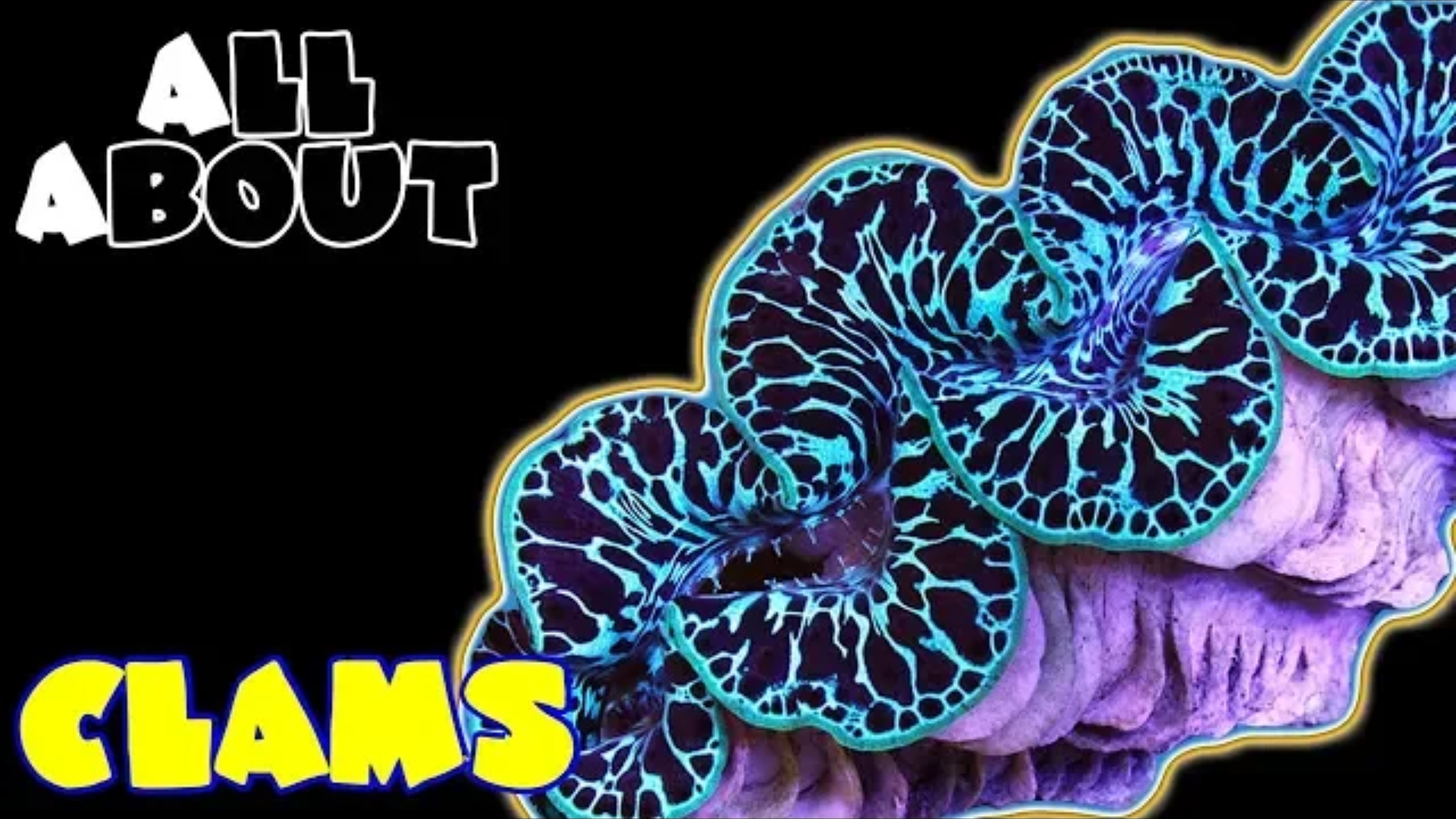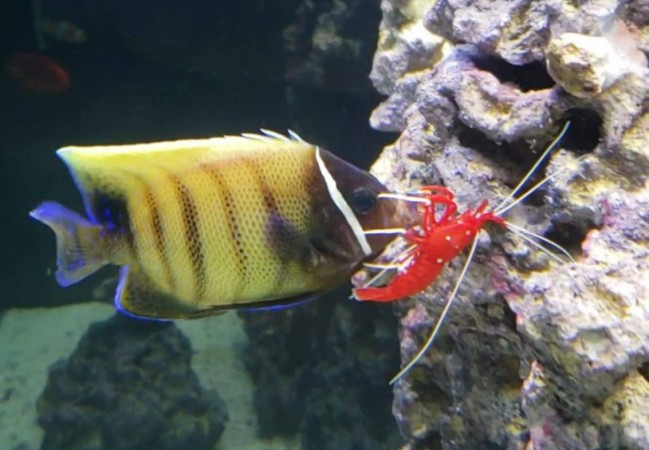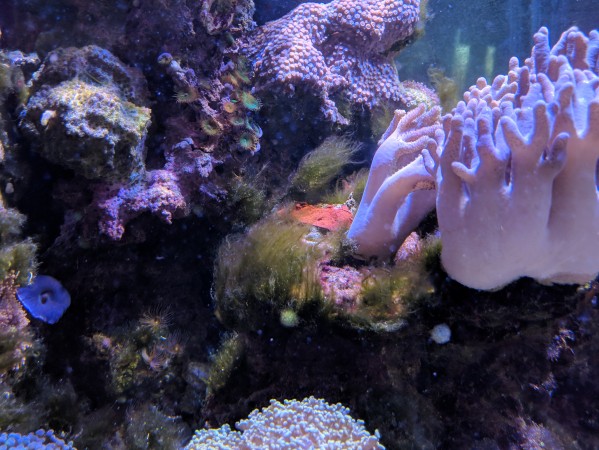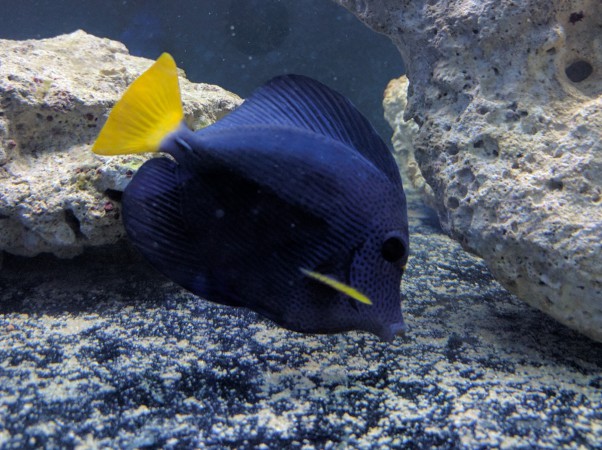- Name:
Squamosa Clam
(View AKA's) - Family: Tridacnidae
- Species: Clam
- Scientific Name: Tridacna squamosa
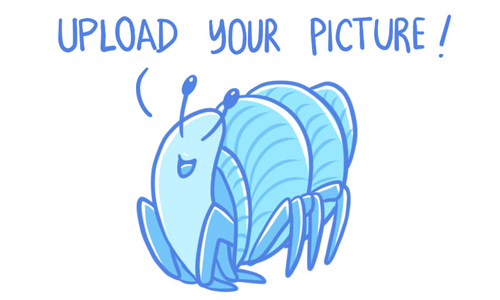
General info about Squamosa Clam
The Squamosa Clam is also referred to as the Scaled Clam, as its species name 'Squamosa' is the Latin word for 'scale'. The numerous rows of large scales over its entire shell are often used as a shelter by other organisms, such as small crabs, bivalves, and other sessile invertebrates. The shell is symmetrical, and the matching growth pattern of its shell allows it to close together very tightly to protect itself from predation. The Squamosa Clam has a wide byssal opening and long tentacles surrounding its incurrent siphon and attaches weakly to a solid substrate with byssal filaments.
This is one of the giant clams, along with the Hippopus Clam, that is highly favored by curio and shell collectors. With its leaf-like scutes, it is described by a number of names reflecting its appearance. Common names include the Fluted Giant Clam, Scaly Clam, Scaled Giant Clam, Scaled Clam, and Fluted Clam. Aquacultured Squamosa Clams will also be referenced to as the Squamosa Clam Cultured. In the wild, Squamosa Clams can be found at depths from 1 to 50 feet, but are most commonly found in water shallower than 20 feet. They occur in the sheltered areas of many different environments. They are found inside and outside of lagoons, patch reefs, reef flats, and steep walls. They will be couched on rubble, soft or sandy bottoms, coral groves, or coral.
Squamosa Clams are most commonly found with a brown mantle with many golden brown or yellow wavy lines. However, the mantle can also be very variable in coloration and quite beautiful. Some varieties are accented on a dark background with green and blue spots, and sometimes rose or purple. The shell of the Squamosa Clam is also quite intriguing, with distinctions unique to this Tridacna clam species. The symmetrical shell has large leaf-like fluted scales, call scutes. As mentioned earlier, in the wild, these scutes provide shelter for other small animals such as little crabs and clams and other invertebrates.
The hinge has an opening called the "byssal opening," where a muscular foot attaches to a hard surface. This opening can be large when the Squamosa Clam is young, but it can close up in adults as the shell grows, to the point where there may be no opening at all. Adults use their weight to keep them in place and can open and close their shell to right themselves if they are pushed over. They have no head, but their soft body consists of a mantle forming an outer wall that encloses a visceral mass containing the body's organs. The mantle protrudes in the form of flaps that are usually patterned. The siphon, also called the intake siphon, is a fleshy tube-like structure that is part of the mantle. The intake siphon is used to direct water flow into the mantle cavity and across the gills.
The Squamosa Clam can be a good choice for a beginning saltwater aquarist with a good sized tank. It's a durable clam that usually does well in reef aquariums and will commonly reach about 12 inches in length. These giant clams can get much larger in the wild, reaching just over 17 inches, but that takes over 60 to 70 years. However, after 50 to 70 years, they may very well reach their maximum size of over 17.72 inches in the wild. They become sexually mature at about 6.3 to 7.8 inches, which is around the time they are 3 to 5 years old. They are all born male and then turn to female as needed. Many aquarists have kept Squamosa clams for decades, however, this genus will live over 200 years in the ocean. Like the Giant Clam, it is very hardy, however, unlike the Giant Clam it is a slow grower and will not quickly outgrow your aquarium.
Squamosa clams will arrive either unattached or attached to small pieces of substrate. They will normally attach to a solid surface within a week or so of being introduced into the aquarium. Once attached to a solid surface, never forcibly remove an attached clam from the substrate or rockwork, as lethal damage to their foot and other tissue will be inevitable. As a last resort, to remove a clam from a hard surface gently cut each byssal thread with a razor blade as close to the attachment point of the rock or solid surface, making sure not to slice or damage any tissue.
Although they are often attached to a hard substrate by their byssus threads, especially when young, they are usually found lying on the substrate and often amongst Acropora corals. As juveniles they have a larger byssal opening, however, large adults do not have this opening, using their weight to keep them in place. They will also open and close their shell to right themselves if they are pushed over. Predators are small pyramidellid snails that bore into their tissue and feed on their bodily fluids. While this is less of a problem in the wild, it is more of an issue in enclosed systems.
In the home aquarium, Squamosa Clams require moderate to high lighting to thrive as they contain the symbiotic algae called zooxanthellae and receive the majority of their nutrition from the light through photosynthesis. Smaller Squamosa Clam that is 2 inches or less in size is much more sensitive to very intense lighting as their membrane is much thinner than larger specimens. For this reason, care should be taken to properly photo-adapt them to the existing reef aquarium lighting in a similar manner to newly introduced stony and soft corals. When adapting a new Squamosa Clam to very intense lighting, it is ideal to set them on a small rock or in a plastic dish with coarse substrate at the bottom of the aquarium. Over time, the clam can then be slowly moved up higher in the aquarium.
Proper water chemistry is very important, and they will thrive when calcium levels of 380- 450 mg/L, an alkalinity level of 8-11 dKH, and a magnesium level of 1280-1350 ppm are maintained. Strontium is incorporated in the shell along with calcium and should also be provided for optimum growth. The addition of iodine to the aquarium will also enhance growth and color. Use caution, as iodine spikes have been known to kill them. Add iodine with the top off water or dose daily, but not at one time in a big weekly dose. They require some nitrogen for proper growth. They will not thrive at a level of 0 nitrates. Nitrate can be added if levels are extremely low, but be careful as nitrates should never exceed 2 mg/L. Provide a minute amount of nitrate that is at least 2 ppm. Since salinity is critical, aim for 1.024 to prevent swinging out of the 1.023 and 1.025 range. Automatic fresh water top offs are highly suggested to keep salinity stable. Keep pH at 8.1 to 8.3, do not let the aquarium exceed a pH above 8.4. For hardness, maintain a dKH of 7.9-12, with the optimal being 9. A temperature between 74 to 86°F is fine, however keeping it closer to 83°F is suggested, and be sure to keep it stable.
The size of the tank should be at least 100 gallons per 12 to 18 inches of clam (though larger is better) as this will help keep water parameters stable. Live rock is necessary and sand is preferred if they will be on the substrate. A mature tank is also important. The tank should be at least 6 months old from the time of adding that last piece of live rock. Once you see Coralline algae growing (that cool pink and purple hard algae) you know your tank is doing well and ready for your clam. They are also not as tolerant of strong fluctuations in water parameters as other Tridacnids, and you really don't want your water parameters to fluctuate too much. So, stable tank conditions with water quality maintained are necessary to keep the Squamosa Clam healthy. Do typical water changes of 10% biweekly, 20% a month, or 5% weekly. It has been noted that 5% weekly water changes replenish many of the needed additives.
Given a large tank with strong lighting and careful attention, Squamosa Clams require little else in the way of care. Their ability to close completely also sets them apart from other clams. They will also reward their owner with their interesting relationship with small creatures that hide in their shell.
Young Squamosa Clams are sometimes confused with the Maxima Clam, mostly because both clams have scutes on their shells. The rows of scutes of a Squamosa Clam are much larger and not as close together as on the Maxima Clam, and the hinge on the Maxima is smaller. Also, the shell of the Squamosa Clam is symmetrical, while the shell of the Maxima Clam is asymmetrical.
Squamosa Clam Diet & Nutrition
They are an omnivore. Most clams fulfill their nutritional requirements by filter feeding and absorbing dissolved organic compounds from the water. Giant clams have gone even further than this, using zooxanthellae to manufacture food for themselves. Larger clams, over 4 inches receive the majority of their nutrition from their zooxanthellae. Squamosa Clams that are under 4 inches do not have enough mantle tissue to provide enough space for zooxanthellae to keep the clam alive. Feed them micro-foods designed for filter feeders such as a yeast-based suspension that has been mechanically whisked, live phytoplankton or commercially prepared micro-foods like 'marine snow' or 'reef snow’.
In the wild, larger clams basically make their own food on days when the light is not strong enough. This shouldn't be an issue in captivity with good lighting, but Squamosa Clams do eat more food than some of the other giant clams, such as the Crocea Clams. Once they are older they will still benefit from phytoplankton foods fed on a regular schedule in an aggressively skimmed tank. If there is a healthy population of fish in the tank, and the clam is over 4” long, it can be fed a little less.
Basic nutrients in the aquarium that giant clams need are calcium, strontium, iodine, and a minute amount of nitrate that is at least 2 ppm. They will not thrive at a level of 0 nitrates.
The frequency of feeding is daily for clams up to 2 inches and several times per week for clams up to 4 inches. Can be fed weekly when full grown but can be fed less if there are plenty of fish in the tank.
Determining Sex of Squamosa Clam
They are all born male and then turn to female as needed. There are no discernible sexual differences.
Breeding & Spawning Squamosa Clam
The giant clams are protandry, meaning they are born male and change to female. Clams will release eggs and sperm that can number into the tens of thousands of eggs. This event tends to happen around sunset. One aquarist noted a spawning clam pulsing out eggs every two minutes. Once the eggs are externally fertilized, the embryos develop into trochophore larva, which is free-swimming. The next stage is the bivalve veliger, which sort of looks like a tiny free-swimming clam. These will find a shallow area of the reef to settle into, often perching on top or on the side of coral outcrops or settling into the substrate.
Common Diseases with Squamosa Clam
The most dangerous predators are the highly prolific pyramidellid snails of the Tathrella, Pyrgiscus, and Turbonilla genera. These are parasitic snails about the size of a grain of rice or smaller, rarely reaching a maximum size of about 7mm in length. These snails attack giant clams with a trunk-like snout called a "proboscis." They punch holes into the clam's soft tissue and then feed on its bodily fluids.
While in nature, giant clams can deal with a few of these parasitic snails, in captivity these snails tend to multiply to dangerous numbers. They may hide in the scutes of the clam or in the substrate by day, but will often be found around the edges of the clam's mantle tissue or byssal gape (large foot hole) after the lights go out. They can produce numerous small, gelatinous, egg masses on the clam's shell. These masses are transparent, so difficult to spot. Before putting it in the tank, scrub your clam's shell vigorously with a toothbrush, or other brush with firm bristles, to remove the snails and their eggs. Be careful not to scrub the clam's soft tissues, as that can cause injury and lead to infection. Inspect your clam regularly for several months and remove any snails you discover.
Another common affliction of giant clams is called the Pinched Mantle disease. The edges of the mantle become pinched and contorted, and the margins won't extend fully. This condition almost always results in death unless treated, and it can spread to other clams. The actual cause of this ailment is unknown, but it may possibly be an attack by some sort of protozoan. An easy treatment, that is is stressful but effective, is to submerge the clam in a freshwater dip for a few minutes. Signs of recovery can take a day or two.
Bubble Mantle is caused by laminar flow directed at the clam or pouring water directly into the aquarium in a way that causes bubbles to form (use a siphon and water pump and/or pour very slowly and carefully or pour into sump only). These bubbles can get stuck in the clam's mantle with can cause illness and death.
The larger of the two holes is gaping open, larger than normal. This is usually due to poor water quality. Stability of your water parameters needs to be checked quickly and addressed.
Squamosa Clam Origin
Squamosa Clam has a very broad range in the wild and is found in Central and South Pacific, the Coral Sea, the Indo-Pacific through the Indian Ocean, and the Red Sea.
Caution with Squamosa Clam
Giant clams are also quite sensitive to chemicals or toxic substances dissolved in the water, so be sure to maintain good water quality. High pH, high salinity, and high temperatures can also cause problems. Avoid large weekly doses of anything, especially iodine, which has been known to kill them
Acclimating Squamosa Clam
They are tolerant of tanks that have T5s or another fluorescent lighting, and some will also do well with Metal Halides or intense LED lighting once acclimated. You can acclimate them to a bright aquarium by using layers of plastic screening between them and the lights. Remove one layer of screening every couple of days until the clam is fully adjusted to the light.
If your Squamosa clam is wild caught, start by putting it in the lower third of your tank. If the clam doesn't open within a few days, move it into a spot with indirect lighting. If the lighting above your tank is good, place the clam at the bottom of your tank. Squamosa's can let loose a good, strong blast of water when they slam their shells shut. So, if you put your clam too close to the top of your tank, you'll end up with water up in your lights.
Original Detail
| Name | Species | Family | Scientific Name | More Detail | Added by |
|---|---|---|---|---|---|
| Squamosa Clam | Clam | Tridacnidae | Tridacna squamosa | The Squamosa Clam is also referred to as the Scaled Clam, as its species name 'Squamosa' is the Latin word for 'scale'. The numerous rows of large scales over its entire shell are often used as a shelter by other organisms, such as small crabs, bivalves, and other sessile invertebrates. The shell is symmetrical, and the matching growth pattern of its shell allows it to close together very tightly to protect itself from predation. The Squamosa Clam has a wide byssal opening and long tentacles surrounding its incurrent siphon and attaches weakly to a solid substrate with byssal filaments. This is one of the giant clams, along with the Hippopus Clam, that is highly favored by curio and shell collectors. With its leaf-like scutes, it is described by a number of names reflecting its appearance. Common names include the Fluted Giant Clam, Scaly Clam, Scaled Giant Clam, Scaled Clam, and Fluted Clam. Aquacultured Squamosa Clams will also be referenced to as the Squamosa Clam Cultured. In the wild, Squamosa Clams can be found at depths from 1 to 50 feet, but are most commonly found in water shallower than 20 feet. They occur in the sheltered areas of many different environments. They are found inside and outside of lagoons, patch reefs, reef flats, and steep walls. They will be couched on rubble, soft or sandy bottoms, coral groves, or coral. Squamosa Clams are most commonly found with a brown mantle with many golden brown or yellow wavy lines. However, the mantle can also be very variable in coloration and quite beautiful. Some varieties are accented on a dark background with green and blue spots, and sometimes rose or purple. The shell of the Squamosa Clam is also quite intriguing, with distinctions unique to this Tridacna clam species. The symmetrical shell has large leaf-like fluted scales, call scutes. As mentioned earlier, in the wild, these scutes provide shelter for other small animals such as little crabs and clams and other invertebrates. The hinge has an opening called the "byssal opening," where a muscular foot attaches to a hard surface. This opening can be large when the Squamosa Clam is young, but it can close up in adults as the shell grows, to the point where there may be no opening at all. Adults use their weight to keep them in place and can open and close their shell to right themselves if they are pushed over. They have no head, but their soft body consists of a mantle forming an outer wall that encloses a visceral mass containing the body's organs. The mantle protrudes in the form of flaps that are usually patterned. The siphon, also called the intake siphon, is a fleshy tube-like structure that is part of the mantle. The intake siphon is used to direct water flow into the mantle cavity and across the gills. The Squamosa Clam can be a good choice for a beginning saltwater aquarist with a good sized tank. It's a durable clam that usually does well in reef aquariums and will commonly reach about 12 inches in length. These giant clams can get much larger in the wild, reaching just over 17 inches, but that takes over 60 to 70 years. However, after 50 to 70 years, they may very well reach their maximum size of over 17.72 inches in the wild. They become sexually mature at about 6.3 to 7.8 inches, which is around the time they are 3 to 5 years old. They are all born male and then turn to female as needed. Many aquarists have kept Squamosa clams for decades, however, this genus will live over 200 years in the ocean. Like the Giant Clam, it is very hardy, however, unlike the Giant Clam it is a slow grower and will not quickly outgrow your aquarium. Squamosa clams will arrive either unattached or attached to small pieces of substrate. They will normally attach to a solid surface within a week or so of being introduced into the aquarium. Once attached to a solid surface, never forcibly remove an attached clam from the substrate or rockwork, as lethal damage to their foot and other tissue will be inevitable. As a last resort, to remove a clam from a hard surface gently cut each byssal thread with a razor blade as close to the attachment point of the rock or solid surface, making sure not to slice or damage any tissue. Although they are often attached to a hard substrate by their byssus threads, especially when young, they are usually found lying on the substrate and often amongst Acropora corals. As juveniles they have a larger byssal opening, however, large adults do not have this opening, using their weight to keep them in place. They will also open and close their shell to right themselves if they are pushed over. Predators are small pyramidellid snails that bore into their tissue and feed on their bodily fluids. While this is less of a problem in the wild, it is more of an issue in enclosed systems. In the home aquarium, Squamosa Clams require moderate to high lighting to thrive as they contain the symbiotic algae called zooxanthellae and receive the majority of their nutrition from the light through photosynthesis. Smaller Squamosa Clam that is 2 inches or less in size is much more sensitive to very intense lighting as their membrane is much thinner than larger specimens. For this reason, care should be taken to properly photo-adapt them to the existing reef aquarium lighting in a similar manner to newly introduced stony and soft corals. When adapting a new Squamosa Clam to very intense lighting, it is ideal to set them on a small rock or in a plastic dish with coarse substrate at the bottom of the aquarium. Over time, the clam can then be slowly moved up higher in the aquarium. Proper water chemistry is very important, and they will thrive when calcium levels of 380- 450 mg/L, an alkalinity level of 8-11 dKH, and a magnesium level of 1280-1350 ppm are maintained. Strontium is incorporated in the shell along with calcium and should also be provided for optimum growth. The addition of iodine to the aquarium will also enhance growth and color. Use caution, as iodine spikes have been known to kill them. Add iodine with the top off water or dose daily, but not at one time in a big weekly dose. They require some nitrogen for proper growth. They will not thrive at a level of 0 nitrates. Nitrate can be added if levels are extremely low, but be careful as nitrates should never exceed 2 mg/L. Provide a minute amount of nitrate that is at least 2 ppm. Since salinity is critical, aim for 1.024 to prevent swinging out of the 1.023 and 1.025 range. Automatic fresh water top offs are highly suggested to keep salinity stable. Keep pH at 8.1 to 8.3, do not let the aquarium exceed a pH above 8.4. For hardness, maintain a dKH of 7.9-12, with the optimal being 9. A temperature between 74 to 86°F is fine, however keeping it closer to 83°F is suggested, and be sure to keep it stable. The size of the tank should be at least 100 gallons per 12 to 18 inches of clam (though larger is better) as this will help keep water parameters stable. Live rock is necessary and sand is preferred if they will be on the substrate. A mature tank is also important. The tank should be at least 6 months old from the time of adding that last piece of live rock. Once you see Coralline algae growing (that cool pink and purple hard algae) you know your tank is doing well and ready for your clam. They are also not as tolerant of strong fluctuations in water parameters as other Tridacnids, and you really don't want your water parameters to fluctuate too much. So, stable tank conditions with water quality maintained are necessary to keep the Squamosa Clam healthy. Do typical water changes of 10% biweekly, 20% a month, or 5% weekly. It has been noted that 5% weekly water changes replenish many of the needed additives. Given a large tank with strong lighting and careful attention, Squamosa Clams require little else in the way of care. Their ability to close completely also sets them apart from other clams. They will also reward their owner with their interesting relationship with small creatures that hide in their shell. Young Squamosa Clams are sometimes confused with the Maxima Clam, mostly because both clams have scutes on their shells. The rows of scutes of a Squamosa Clam are much larger and not as close together as on the Maxima Clam, and the hinge on the Maxima is smaller. Also, the shell of the Squamosa Clam is symmetrical, while the shell of the Maxima Clam is asymmetrical. |
Admin |
Changed by users
| Submitted Date | Submitted By | Status | Action |
|---|---|---|---|
| 2019-01-22 10:34:35 | merve kutsal | Approved | Edit |
| 2019-01-22 10:16:25 | merve kutsal | Approved | Edit |
| 2019-01-22 09:34:32 | merve kutsal | Approved | Edit |
| 2019-01-22 09:09:12 | merve kutsal | Approved | Edit |
| 2019-01-21 21:40:42 | merve kutsal | Approved | Edit |
| 2019-01-21 21:35:15 | merve kutsal | Approved | Edit |


